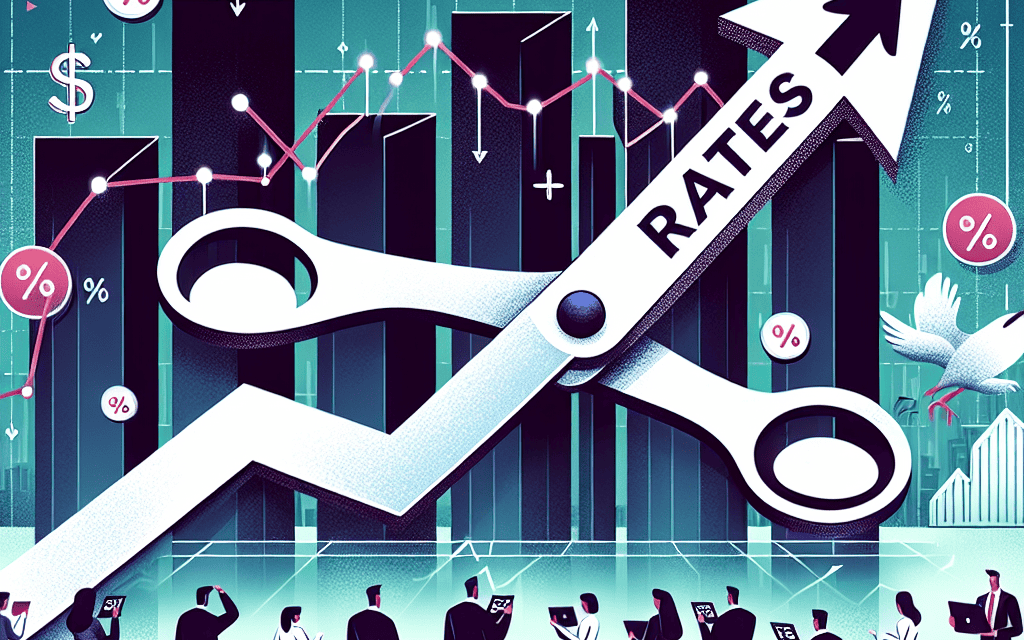“Fed Rate Cuts: Fuel for Market Momentum or Cautionary Tale?”
Introduction
When the Federal Reserve announces a rate cut, it often triggers a significant reaction in the stock markets. A rate cut typically signals the Fed’s intention to stimulate economic growth by making borrowing cheaper, thereby encouraging spending and investment. This can lead to increased investor confidence, as lower interest rates can boost corporate profits and consumer spending. Consequently, stock prices may rise as investors anticipate improved economic conditions and higher future earnings for companies. However, the market’s reaction can vary depending on the broader economic context and investor expectations. If a rate cut is seen as a response to severe economic distress, it might lead to uncertainty and volatility, as investors weigh the potential benefits against underlying economic concerns. Thus, while Fed rate cuts generally have a positive impact on stock markets, the specific circumstances surrounding each decision play a crucial role in shaping market reactions.
Historical Analysis Of Stock Market Reactions To Fed Rate Cuts
The relationship between Federal Reserve rate cuts and stock market reactions has long been a subject of interest for economists, investors, and policymakers alike. Historically, the Federal Reserve, often referred to as the Fed, adjusts interest rates as a tool to influence economic activity. When the Fed cuts rates, it typically aims to stimulate economic growth by making borrowing cheaper, thereby encouraging spending and investment. However, the stock market’s reaction to such monetary policy changes is not always straightforward and can vary depending on a multitude of factors.
To understand the historical reactions of stock markets to Fed rate cuts, it is essential to consider the context in which these cuts occur. Generally, rate cuts are implemented during periods of economic slowdown or uncertainty. In such scenarios, the stock market may initially react positively to the news of a rate cut, as investors anticipate that lower borrowing costs will boost corporate profits and economic activity. For instance, during the financial crisis of 2008, the Fed’s aggressive rate cuts were met with initial optimism in the stock markets, as investors hoped for a swift economic recovery.
However, the positive impact of rate cuts on stock markets is not always guaranteed. In some cases, the announcement of a rate cut may be perceived as a signal that the economy is in worse shape than previously thought, leading to increased uncertainty and volatility in the markets. This was evident in the early 2000s when the Fed cut rates in response to the bursting of the dot-com bubble. Despite the rate cuts, stock markets continued to struggle as investors remained wary of the underlying economic conditions.
Moreover, the timing and magnitude of rate cuts can also influence market reactions. A well-timed and appropriately sized rate cut can instill confidence among investors, leading to a sustained rally in stock prices. Conversely, if the market perceives the rate cut as too little or too late, it may result in a muted or even negative reaction. For example, during the early stages of the COVID-19 pandemic in 2020, the Fed’s emergency rate cuts were initially met with skepticism, as investors questioned whether monetary policy alone could address the unprecedented economic challenges posed by the pandemic.
Additionally, the broader economic environment and investor sentiment play crucial roles in shaping market reactions to Fed rate cuts. In a robust economic environment with strong corporate earnings and low inflation, rate cuts can act as a catalyst for further market gains. On the other hand, in a weak economic environment with high uncertainty, the same rate cuts may fail to provide the desired boost to stock markets.
In conclusion, while Fed rate cuts are generally intended to stimulate economic activity and can lead to positive stock market reactions, the actual outcomes are influenced by a complex interplay of factors. Historical analysis reveals that the context of the rate cut, including the prevailing economic conditions, investor sentiment, and the timing and magnitude of the cut, all contribute to the market’s response. As such, investors and policymakers must consider these variables when assessing the potential impact of Fed rate cuts on stock markets. Understanding these dynamics can provide valuable insights into the intricate relationship between monetary policy and market behavior.
Sector-Specific Impacts Of Fed Rate Cuts On Stock Markets
When the Federal Reserve announces a rate cut, the immediate reaction in the stock markets is often one of heightened volatility, as investors scramble to adjust their portfolios in response to the new monetary policy landscape. However, the impact of such rate cuts is not uniform across all sectors. Instead, it varies significantly depending on the specific characteristics and financial health of each sector. Understanding these sector-specific impacts is crucial for investors aiming to navigate the complexities of the stock market during periods of monetary easing.
To begin with, the financial sector is typically one of the most directly affected by changes in interest rates. Banks, for instance, often experience a squeeze on their net interest margins when rates are cut, as the difference between the interest they earn on loans and the interest they pay on deposits narrows. This can lead to a decline in profitability, which may negatively impact bank stocks. However, lower rates can also stimulate borrowing and economic activity, potentially offsetting some of the negative effects on financial institutions over the longer term.
In contrast, the real estate sector often benefits from rate cuts. Lower interest rates reduce the cost of borrowing, making mortgages more affordable and encouraging home buying and real estate investment. This can lead to increased demand for housing and commercial properties, boosting the performance of real estate stocks. Additionally, real estate investment trusts (REITs) may see an uptick in value as investors seek higher yields in a low-interest-rate environment.
The consumer discretionary sector also tends to react positively to rate cuts. With lower borrowing costs, consumers are more likely to finance big-ticket purchases such as cars and appliances, driving up sales for companies in this sector. Moreover, increased consumer spending can lead to higher revenues and improved earnings for retailers and manufacturers, which can, in turn, bolster their stock prices.
On the other hand, the utilities sector may not experience the same level of benefit from rate cuts. Utilities are often seen as defensive stocks, providing stable dividends and steady returns regardless of economic conditions. While lower rates can reduce the cost of capital for utility companies, the sector’s growth prospects are generally less sensitive to changes in interest rates compared to more cyclical industries.
The technology sector, known for its growth potential, can also be positively influenced by rate cuts. Lower interest rates reduce the cost of financing for tech companies, many of which rely on borrowing to fund research and development and expansion efforts. This can lead to increased innovation and growth, making tech stocks more attractive to investors seeking capital appreciation.
In summary, while Fed rate cuts can lead to a broad-based rally in the stock market, the effects are not evenly distributed across all sectors. Financials may face challenges due to compressed margins, while real estate and consumer discretionary sectors often benefit from increased borrowing and spending. Utilities may see limited impact, whereas technology companies could gain from cheaper financing. Investors must consider these sector-specific dynamics when making investment decisions in response to changes in monetary policy. By doing so, they can better position themselves to capitalize on the opportunities and mitigate the risks associated with Fed rate cuts.
Short-Term Versus Long-Term Stock Market Responses To Fed Rate Cuts
When the Federal Reserve announces a rate cut, the immediate reaction in the stock markets is often one of heightened volatility. Investors, analysts, and traders alike scramble to interpret the implications of the Fed’s decision, leading to swift movements in stock prices. In the short term, rate cuts are generally perceived as positive for the stock market. This is primarily because lower interest rates reduce the cost of borrowing, encouraging businesses to invest and expand. Consequently, this can lead to increased corporate earnings, which are a key driver of stock prices. Additionally, lower rates make fixed-income investments like bonds less attractive, prompting investors to seek higher returns in the stock market.
However, the initial euphoria following a rate cut can sometimes be tempered by underlying economic concerns. The Federal Reserve typically reduces interest rates in response to signs of economic weakness or to stave off potential downturns. Therefore, while the immediate effect might be a rally in stock prices, investors may also be wary of the reasons behind the rate cut. If the market perceives the rate cut as a response to severe economic distress, the initial positive reaction might be short-lived, giving way to caution and even pessimism.
Transitioning to the long-term effects, the impact of Fed rate cuts on the stock market becomes more complex and nuanced. Over an extended period, the benefits of lower borrowing costs can lead to sustained economic growth, which in turn supports higher stock prices. Companies can take advantage of cheaper credit to finance new projects, expand operations, and increase hiring, all of which contribute to a healthier economy and potentially higher stock valuations. Moreover, consumer spending often rises as individuals benefit from lower interest rates on loans and mortgages, further bolstering economic activity and corporate profits.
Nevertheless, the long-term response of the stock market to Fed rate cuts is not always straightforward. If rate cuts are perceived as a sign that the economy is struggling, investor confidence may wane, leading to a more cautious approach to stock investments. Additionally, prolonged periods of low interest rates can lead to asset bubbles, as investors chase higher returns in riskier assets. This can create an unstable market environment, where stock prices are inflated beyond their intrinsic values, setting the stage for potential corrections.
Furthermore, the effectiveness of rate cuts in stimulating the economy and supporting the stock market can be influenced by other factors, such as fiscal policy, global economic conditions, and geopolitical events. For instance, if fiscal policy is not aligned with monetary policy, the impact of rate cuts may be muted. Similarly, adverse global economic developments or geopolitical tensions can overshadow the positive effects of lower interest rates, leading to uncertainty and volatility in the stock markets.
In conclusion, while Fed rate cuts often lead to an immediate positive reaction in the stock markets, the long-term effects are shaped by a myriad of factors. The initial boost in stock prices may be tempered by concerns about the underlying economic conditions that prompted the rate cut. Over time, the benefits of lower borrowing costs can support economic growth and higher stock valuations, but this is contingent upon broader economic and geopolitical stability. As such, investors must carefully consider both the short-term and long-term implications of Fed rate cuts when making investment decisions.
Investor Sentiment And Stock Market Volatility Following Fed Rate Cuts

Investor sentiment and stock market volatility are intricately linked to the actions of the Federal Reserve, particularly when it comes to adjustments in interest rates. When the Federal Reserve announces a rate cut, it often signals an attempt to stimulate economic activity by making borrowing cheaper, thereby encouraging spending and investment. This monetary policy tool is closely watched by investors, as it can have profound implications for the stock market. Understanding how stock markets react to Fed rate cuts requires an examination of investor sentiment and the resulting volatility.
Initially, a Fed rate cut is often perceived positively by investors, as it suggests a more accommodative monetary policy stance aimed at fostering economic growth. This perception can lead to a surge in investor confidence, as lower interest rates reduce the cost of borrowing for companies, potentially boosting corporate profits. Consequently, stock prices may rise in anticipation of improved financial performance. Moreover, lower interest rates make fixed-income investments less attractive, prompting investors to seek higher returns in the stock market, further driving up stock prices.
However, the relationship between Fed rate cuts and stock market reactions is not always straightforward. While the initial response may be positive, the underlying reasons for the rate cut can introduce uncertainty and volatility. For instance, if the rate cut is implemented in response to signs of economic weakness or a looming recession, investor sentiment may become cautious. In such cases, the optimism surrounding lower borrowing costs may be overshadowed by concerns about the broader economic outlook. This duality can lead to increased volatility, as investors weigh the benefits of lower rates against potential economic challenges.
Furthermore, the timing and magnitude of the rate cut play crucial roles in shaping investor sentiment. A well-timed and appropriately sized rate cut can reassure investors that the Federal Reserve is proactively managing economic risks. Conversely, an unexpected or aggressive rate cut might be interpreted as a signal that the economic situation is more dire than previously thought, leading to heightened uncertainty and market turbulence. Therefore, the context in which a rate cut occurs is pivotal in determining its impact on investor sentiment and market volatility.
In addition to these factors, the communication strategy of the Federal Reserve also influences market reactions. Clear and transparent communication regarding the rationale behind a rate cut can help manage investor expectations and reduce uncertainty. When the Fed effectively conveys its intentions and economic assessments, it can mitigate adverse reactions and stabilize investor sentiment. Conversely, ambiguous or inconsistent messaging can exacerbate market volatility, as investors struggle to interpret the central bank’s policy direction.
In conclusion, the reaction of stock markets to Fed rate cuts is a complex interplay of investor sentiment and market volatility. While rate cuts are generally intended to stimulate economic activity and boost investor confidence, the broader economic context, timing, and communication strategy of the Federal Reserve significantly influence market responses. Investors must carefully consider these factors when assessing the potential impact of Fed rate cuts on their portfolios. By understanding the nuances of how investor sentiment and market volatility interact with monetary policy decisions, investors can make more informed decisions in navigating the ever-changing landscape of the stock market.
Comparing Stock Market Reactions To Expected Versus Unexpected Fed Rate Cuts
The stock market’s reaction to Federal Reserve rate cuts is a topic of perennial interest to investors, economists, and policymakers alike. Understanding how these reactions differ when rate cuts are anticipated versus when they come as a surprise is crucial for making informed investment decisions. When the Federal Reserve announces a rate cut, it typically aims to stimulate economic activity by making borrowing cheaper, thereby encouraging spending and investment. However, the stock market’s response can vary significantly depending on whether the rate cut was expected or unexpected.
In scenarios where a rate cut is anticipated, the stock market often begins to price in the potential benefits well before the official announcement. Investors, guided by economic indicators and Fed communications, may adjust their portfolios in anticipation of the cut. As a result, the actual announcement may have a muted impact on stock prices, as much of the positive sentiment has already been factored in. This preemptive adjustment can lead to a more stable market environment, as investors have had time to digest the implications of the rate cut and align their strategies accordingly.
Conversely, when a rate cut is unexpected, the stock market’s reaction can be more volatile. An unanticipated rate cut may signal to investors that the Federal Reserve is responding to unforeseen economic weaknesses or risks. This can lead to a mixed reaction in the stock market. On one hand, the immediate reduction in interest rates can boost investor confidence, as it suggests that the Fed is taking proactive measures to support the economy. On the other hand, the surprise element may also introduce uncertainty, prompting concerns about the underlying reasons for the Fed’s decision. This duality can result in sharp fluctuations in stock prices as investors reassess their positions in light of the new information.
Moreover, the context in which a rate cut occurs plays a significant role in shaping market reactions. During periods of economic expansion, an expected rate cut might be viewed positively, as it could further fuel growth. However, in times of economic downturn, even an anticipated rate cut might not be enough to assuage investor fears, leading to more subdued market responses. In contrast, an unexpected rate cut during a downturn might be interpreted as a sign of deeper economic troubles, potentially exacerbating market volatility.
Additionally, the communication strategy of the Federal Reserve can influence how rate cuts are perceived. Clear and consistent messaging can help manage market expectations, reducing the likelihood of unexpected rate cuts and their associated volatility. When the Fed provides forward guidance, it allows investors to better anticipate policy moves, thereby smoothing market reactions. However, if the Fed’s communications are ambiguous or inconsistent, it can lead to misinterpretations and heightened market sensitivity to rate changes.
In conclusion, the stock market’s reaction to Federal Reserve rate cuts is complex and influenced by a multitude of factors. Expected rate cuts tend to result in more measured market responses, as investors have time to adjust their strategies in advance. In contrast, unexpected rate cuts can lead to heightened volatility, as they introduce elements of surprise and uncertainty. The broader economic context and the Fed’s communication strategy further shape these reactions, underscoring the importance of understanding the nuances of monetary policy and its impact on financial markets.
The Role Of Economic Indicators In Stock Market Reactions To Fed Rate Cuts
The relationship between Federal Reserve rate cuts and stock market reactions is a complex interplay influenced by various economic indicators. Understanding this dynamic requires a comprehensive analysis of how these indicators shape investor expectations and market behavior. When the Federal Reserve announces a rate cut, it is often in response to economic conditions that warrant monetary easing. These conditions are typically reflected in key economic indicators such as inflation rates, unemployment figures, and GDP growth. Each of these indicators plays a crucial role in determining how the stock market will react to a change in interest rates.
Inflation is one of the primary indicators that the Federal Reserve monitors when deciding on interest rate adjustments. A rate cut is generally aimed at stimulating economic activity by making borrowing cheaper, thereby encouraging spending and investment. If inflation is low, a rate cut might be seen as a positive move to boost economic growth, leading to a favorable reaction in the stock market. Conversely, if inflation is high, a rate cut could be perceived as a risky move that might exacerbate inflationary pressures, potentially leading to a negative market reaction.
Unemployment figures also significantly influence stock market responses to Fed rate cuts. High unemployment rates often signal economic distress, prompting the Federal Reserve to lower interest rates to stimulate job creation and economic activity. In such scenarios, a rate cut can be viewed positively by investors, as it suggests a proactive approach to fostering economic recovery. However, if unemployment is already low, a rate cut might raise concerns about the economy overheating, which could lead to a more cautious or even adverse market response.
GDP growth is another critical economic indicator that affects how stock markets react to Fed rate cuts. Strong GDP growth typically indicates a healthy economy, reducing the need for monetary stimulus. In such cases, a rate cut might be interpreted as an unnecessary intervention, potentially leading to skepticism among investors. On the other hand, if GDP growth is sluggish or contracting, a rate cut could be welcomed as a necessary measure to reignite economic momentum, likely resulting in a positive market reaction.
Moreover, the stock market’s reaction to Fed rate cuts is not solely determined by domestic economic indicators. Global economic conditions and geopolitical events can also play a significant role. For instance, if global economic indicators suggest a downturn, a Fed rate cut might be seen as a preemptive measure to shield the domestic economy from external shocks, which could bolster investor confidence and lead to a rally in the stock market. Conversely, if global conditions are stable or improving, the necessity of a rate cut might be questioned, potentially leading to a more muted market response.
In addition to these economic indicators, investor sentiment and market expectations are crucial in shaping stock market reactions to Fed rate cuts. If investors anticipate a rate cut and it aligns with their expectations, the market reaction might be subdued, as the decision is already priced in. However, if the rate cut is unexpected or deviates from market expectations, it can lead to significant volatility as investors reassess their strategies in light of the new monetary policy stance.
In conclusion, the stock market’s reaction to Fed rate cuts is influenced by a myriad of economic indicators, each providing valuable insights into the underlying economic conditions. By analyzing these indicators, investors can better understand the potential implications of rate cuts and make more informed decisions in navigating the complexities of the financial markets.
Case Studies: Notable Stock Market Movements After Major Fed Rate Cuts
The relationship between Federal Reserve rate cuts and stock market movements has long been a subject of interest for economists, investors, and policymakers alike. Understanding how stock markets react to these monetary policy decisions can provide valuable insights into market dynamics and investor behavior. Historically, rate cuts by the Federal Reserve have been perceived as a tool to stimulate economic growth, often leading to notable movements in stock markets. By examining several case studies of major Fed rate cuts, we can better comprehend the complexities of these reactions.
One of the most significant instances of a Fed rate cut occurred during the financial crisis of 2008. In response to the rapidly deteriorating economic conditions, the Federal Reserve implemented a series of aggressive rate cuts, bringing the federal funds rate down to near zero. This unprecedented move was aimed at stabilizing the financial system and encouraging lending and investment. Initially, the stock market reacted positively, with major indices experiencing a temporary surge. However, the optimism was short-lived as the severity of the economic downturn became apparent, leading to heightened volatility and further declines in stock prices. This case illustrates that while rate cuts can provide a temporary boost to investor confidence, they are not always sufficient to counteract broader economic challenges.
Transitioning to another notable example, the rate cuts in the early 2000s following the dot-com bubble burst offer additional insights. In an effort to mitigate the economic slowdown, the Federal Reserve reduced interest rates multiple times between 2001 and 2003. The stock market’s response was mixed; initially, there was a positive reaction as lower rates were expected to support economic recovery. However, the prolonged period of low rates also contributed to the housing market bubble, which eventually led to the financial crisis of 2008. This case underscores the complexity of predicting stock market reactions, as short-term gains can sometimes lead to long-term consequences.
Moreover, examining the rate cuts in response to the COVID-19 pandemic in 2020 provides a contemporary perspective. Faced with an unprecedented global health crisis, the Federal Reserve swiftly cut rates to near zero and implemented various quantitative easing measures. The immediate reaction of the stock market was one of extreme volatility, with sharp declines followed by rapid recoveries. The rate cuts, combined with fiscal stimulus measures, played a crucial role in stabilizing financial markets and supporting economic recovery. This case highlights the importance of coordinated policy responses in influencing market behavior during times of crisis.
In conclusion, the reaction of stock markets to Fed rate cuts is influenced by a myriad of factors, including the broader economic context, investor sentiment, and the perceived effectiveness of monetary policy measures. While rate cuts are generally intended to stimulate economic activity and boost investor confidence, their impact on stock markets can vary significantly depending on the prevailing economic conditions. As demonstrated by these case studies, the initial positive reactions to rate cuts can be tempered by underlying economic challenges or unintended consequences. Therefore, while Fed rate cuts are a powerful tool in the central bank’s arsenal, their effects on stock markets are complex and multifaceted, requiring careful analysis and consideration.
Q&A
1. **What is a Fed rate cut?**
A Fed rate cut refers to the Federal Reserve lowering the federal funds rate, which is the interest rate at which banks lend to each other overnight.
2. **How do stock markets typically react to a Fed rate cut?**
Stock markets often react positively to a Fed rate cut as it can lower borrowing costs, stimulate economic growth, and increase corporate profits.
3. **Why might a Fed rate cut lead to increased stock prices?**
Lower interest rates can make equities more attractive compared to bonds, encourage consumer spending, and boost business investment, all of which can drive stock prices up.
4. **Can a Fed rate cut ever lead to a negative reaction in stock markets?**
Yes, if investors interpret the rate cut as a sign of economic weakness or impending recession, it can lead to a negative reaction in stock markets.
5. **How do different sectors react to Fed rate cuts?**
Interest-sensitive sectors like real estate and utilities often benefit from rate cuts, while financials may face pressure due to narrower interest margins.
6. **What is the long-term impact of Fed rate cuts on stock markets?**
In the long term, the impact depends on the broader economic context; rate cuts can support a bull market if they successfully stimulate growth, but may have limited effect if underlying economic issues persist.
7. **How do expectations of a Fed rate cut influence stock markets?**
Markets often price in expected rate cuts ahead of time, so the actual announcement may have a muted effect if it aligns with investor expectations.
Conclusion
Stock markets typically react positively to Federal Reserve rate cuts, as lower interest rates reduce borrowing costs for businesses and consumers, potentially stimulating economic activity. Rate cuts can lead to increased corporate profits and higher consumer spending, which are favorable for stock prices. Additionally, lower rates make equities more attractive compared to fixed-income investments, often resulting in increased demand for stocks. However, the context of the rate cut is crucial; if cuts are made in response to severe economic downturns, the initial positive reaction may be tempered by concerns about underlying economic weaknesses. Overall, while Fed rate cuts generally boost stock markets, the broader economic environment and investor sentiment play significant roles in determining the extent and duration of the market’s response.





